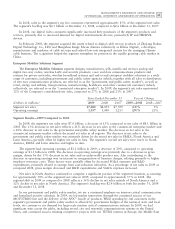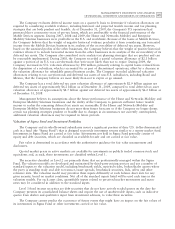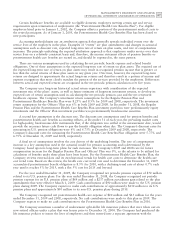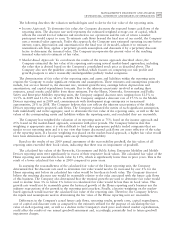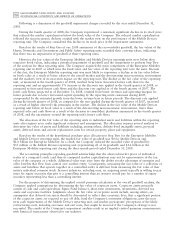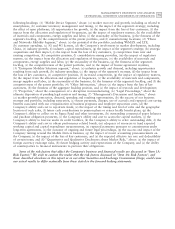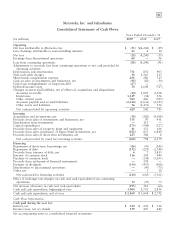Motorola 2009 Annual Report Download - page 79
Download and view the complete annual report
Please find page 79 of the 2009 Motorola annual report below. You can navigate through the pages in the report by either clicking on the pages listed below, or by using the keyword search tool below to find specific information within the annual report.
71
MANAGEMENT’S DISCUSSION AND ANALYSIS
OF FINANCIAL CONDITION AND RESULTS OF OPERATIONS
Long-lived Assets: Long-lived assets include property, plant and equipment, intangible assets, long-term
prepaid assets and other non-current assets. The Company reviews long-lived assets held for use for impairment
whenever events or changes in circumstances indicate that the carrying amount may not be recoverable. Events
which may indicate long-lived assets held for use may not be recoverable include, but are not limited to, a
significant decrease in the market price of long-lived assets, a significant adverse change in the manner in which
the Company utilizes a long-lived asset, a significant adverse change in the business climate, a recent history of
operating or cash flow losses, or a current expectation that it is more likely than not that a long-lived asset will
be sold or disposed of in the future. For impairment testing purposes, the Company groups its long-lived assets at
the lowest level for which identifiable cash flows are largely independent of the cash flows of other groups of
assets and liabilities (the asset group).
If the Company determines that a long-lived asset or asset group may not be recoverable, it compares the
sum of the expected undiscounted future cash flows that the asset or asset group is expected to generate over the
estimated remaining useful life of the asset or asset group to the asset or asset group’s carrying value. If the sum
of the expected undiscounted future cash flows exceeds the carrying amount of the asset or asset group, the asset
or asset group is not considered impaired. However, if the sum of the undiscounted future cash flows is less than
the carrying amount of the asset or asset group, a loss is recognized for the difference between the fair value of
the asset or asset group and the carrying value of the asset or asset group. The fair value of the asset or asset
group is generally determined by discounting the expected future cash flows using a discount rate that is
commensurate with the risk associated with the amount and timing of the expected future cash flows. Market-
based or cost-based approaches to determining fair value may also be considered.
No long-lived assets or asset groups held and used were tested for impairment during 2009. During 2008,
the Company tested two asset groups for impairment. The first asset group was tested for impairment when it
was determined that there was a more likely than not expectation that assets associated with a technology
platform of the Enterprise Mobility segment would be disposed of or sold. This determination was made because
the technology platform was no longer considered strategic to the Company. The Company determined that the
expected future cash flows, which incorporated this change in the strategic direction of the platform, did not
support its carrying amount. As a result, the assets, consisting primarily of intangible assets, were written down
to their fair values. The Company recorded an impairment charge of $121 million during 2008 to reduce the
carrying amount of the asset group to its fair value.
During the fourth quarter of 2008, due to the continued operating losses of the Mobile Devices segment, the
Company tested the long-lived assets of the Mobile Devices segment for impairment. The long-lived assets of the
Mobile Devices segment consisted primarily of property, plant and equipment and long-term pre-paid licenses.
The asset group also included elements of working capital, including inventory and accounts receivable. The
Company considered future cash flows expected to be generated by the business and weighted them according to
management’s view of their probability-weighted outcomes. The sum of these probability-weighted undiscounted
future cash flows indicated that the asset group was recoverable. As a result, no impairment of long-lived assets
was recorded at the Mobile Devices segment. A significant assumption in the expected future cash flow forecast
was that it was more likely than not that management will be successful in its plans to turn around the Mobile
Devices business. The plan to turn around Mobile Devices includes a successful execution of the segment’s
software platform strategy and the Company’s ability to execute its cost savings initiatives. Expectations of future
cash flows could change if the Company determines it will not be successful in executing its plans to turn around
the Mobile Devices business. Impairment charges of the long-lived assets of Mobile Devices could be required in
future periods if the Company’s expectations of future cash flows changes.
Recent Accounting Pronouncements
In October 2009, the Financial Accounting Standards Board (‘‘FASB’’) issued new accounting guidance
related to the recognition of revenue for multiple-deliverable arrangements. Under the new guidance, revenue may
be allocated to the different elements in an arrangement based on relative estimated sales price. Also in October
2009, the FASB issued new accounting standards altering the scope of revenue recognition guidance for software
deliverables to exclude items sold that include hardware with software that is essential to the hardware’s
functionality. This new guidance will be effective prospectively for revenue arrangements entered into or
materially modified in fiscal years beginning on or after June 15, 2010. Early adoption is permitted. The
Company is still assessing the potential impact of adopting this new guidance, but anticipates adopting the
guidance prospectively in the first quarter of 2010 and, as a result, deferring less revenue under the new guidance
than in prior periods.


